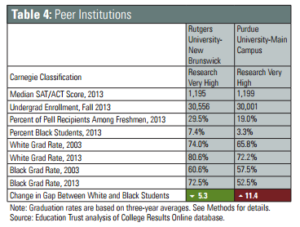
(AP Photo/Jose Luis Magana)
What should be done to increase the number of Blacks graduating from college? When it comes to Black college students, the good news is that more of them are leaving with a degree than a decade ago. The bad news is that the racial gap between Black and white students remains, and in some instances has even been exacerbated. And what takes place inside the halls of the institution, in terms of the environment created for these students, can make all the difference in the world.
Rising Tide II: Do Black Students Benefit as Grad Rates Increase?, a new report from The Education Trust — a nonprofit which advocates for high academic achievement among low-income students of color — found that between 2003 and 2013, African-American graduation rates increased at almost 70 percent at the 232 four-year public colleges they examined. However, nearly one-third (or 73) of the colleges and universities that improved overall graduation rates failed to do so for Black students, with Black success rates remaining flat or dropping. Further, 27 of those schools experienced a drop in Black graduation rates and significantly widening gaps.
Overall, the report found that over the past decade, the graduation rate for Black students increased only 4.4 percentage points, as opposed to 56 points for whites.
“Moreover, because graduation rates for black students have shown less progress, the gap in completion between white and black students has grown,” according to the report. “Graduation rates for black students must increase at a much faster pace if the long-standing gap between black students and their white peers is to close.”

The Education Trust
Across the country, Black students are calling upon their colleges to address on-campus racial discrimination and barriers to success, with the University of Missouri — where Black students staged a hunger strike and the football team refused to play until student demands were met — being a most prominent example. The report notes that Mizzou has a long way to go, with graduation rates for Black students declining slightly, resulting in a 14.5-point gap in the Black-white graduation rate.
Some colleges are experiencing improvements for Black students. For example, at The Ohio State University, graduation rates for Black students have increased faster than those of their white peers, up 31.1 percentage points for Blacks and 20.5 points for whites. As a result, the graduation rate gap was slashed in half, from 22.5 points to 11.9 points. In addition, at the University at Buffalo, Black graduation rates have increased more than 20 points over the past decade, to 63.5 percent in 2013. Meanwhile, the gap between white and Black students dropped to 8.8 points.

The Education Trust
Moreover, the Education Trust found that even similar institutions can emerge with markedly different outcomes. For example, Rutgers University–New Brunswick and Purdue University enroll similar students, have comparable admission criteria and have student bodies of more than 30,000 students, with a similar share of Black students. Yet, Rutgers presents a much different picture of student success, with increasing graduation rates and a significant narrowing of the gap between Black and white students to 8 points. On the other hand, the racial gap at Purdue doubled to nearly 20 points during the same time period, and graduation rates among Blacks dipped to slightly over 50 percent.
There are clear pathways and techniques for success. For example, Mentor Tech is a program at Texas Tech which pairs students of color with faculty, and also connects them to local churches and community groups.
“The mentors we match them with commit to assisting them with navigating the system, sharing the unwritten rules of culture, connecting them with resources, being that listening ear, being that caring arm, and sometimes being that voice of correction to help them bounce back from failure,” Cory Powell, the director of Mentor Tech, told Education Trust. As a result of this initiative, the graduation rate for Black students at Texas Tech — 56 percent — has soared 19 points over the past decade.
And Ohio State’s longstanding Young Scholars Program connects low-income, first-generation middle-school students to the college, 75 percent of whom are Black. The university works with the kids on study skills and standardized test preparation, and other tools they will require for admission.
“[Students] begin to think of themselves as college students well before they get here — and capable of college work,” says Sharon Davies, chief diversity officer. YSP students who eventually attend Ohio State receive a need-based, four-year scholarship averaging $15,605 per year. Further, they participate in summer programs and are provided with on-campus support such as a mentor, a success coach, and techniques for success.
“So they’re not just taking exams,” Rochelle Woods, YSP director told the Education Trust, “but they’re understanding what they did or didn’t do that had an impact on that grade.”
There is no one-size-fits-all solution to turning things around for these Black students, but it is clear that in order to ensure Black success, these institutions must make it a priority. As the report emphasizes, “improving achievement among black students should not only be the prerogative of one university or city, but the collective attention and efforts of a nation wanting a stronger, sustainable workforce.”


